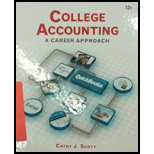
Concept explainers
After all revenue and expenses have been closed at the end of the fiscal period ended December 31, Income Summary has a debit of $45,550 and a credit of $36,520. On the same date, D. Mau, Drawing has a debit balance of $12,000 and D. Mau, Capital had a beginning credit balance of $63,410.
- a.
Journalize the entries to close the remaining temporary accounts. - b. What is the new balance of D. Mau, Capital after closing the remaining temporary accounts? Show your calculations.
Trending nowThis is a popular solution!

Chapter 5 Solutions
College Accounting (Book Only): A Career Approach
Additional Business Textbook Solutions
Gitman: Principl Manageri Finance_15 (15th Edition) (What's New in Finance)
Horngren's Cost Accounting: A Managerial Emphasis (16th Edition)
Fundamentals of Management (10th Edition)
Operations Management: Processes and Supply Chains (12th Edition) (What's New in Operations Management)
Financial Accounting, Student Value Edition (5th Edition)
Marketing: An Introduction (13th Edition)
- Century 21 Accounting Multicolumn JournalAccountingISBN:9781337679503Author:GilbertsonPublisher:Cengage
 Intermediate Accounting: Reporting And AnalysisAccountingISBN:9781337788281Author:James M. Wahlen, Jefferson P. Jones, Donald PagachPublisher:Cengage Learning
Intermediate Accounting: Reporting And AnalysisAccountingISBN:9781337788281Author:James M. Wahlen, Jefferson P. Jones, Donald PagachPublisher:Cengage Learning - Principles of Accounting Volume 1AccountingISBN:9781947172685Author:OpenStaxPublisher:OpenStax College



